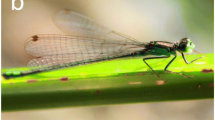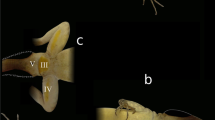Abstract
Female-limited polymorphism is often attributed to selection to avoid excessive male mating attempts. It is encountered in various taxonomic groups, but is particularly common in damselflies, where one female morph (andromorph) typically resembles the conspecific male in colour pattern, while the other(s) (gynomorph(s)) do not. Two sets of theories have been proposed to explain the phenomenon in damselflies, which can be classified as the learned mate recognition (LMR) and male mimicry (MM) hypotheses. To test predictions of these hypotheses, we evaluated the rate of male sexual response towards female morphs and conspecific males in the damselfly Nehalennia irene. The LMR hypothesis predicts that males should respond sexually to andromorphs at greater rates in populations containing a higher relative frequency of andromorphs. The MM hypothesis predicts that males respond more often sexually to both andromorphs and males as the ratio of andromorphs to males increases. While LMR predicts that the rate of mating attempts towards gynomorphs should vary, the MM predicts that it should be relatively fixed. On experimentally presenting live specimens to focal males in five different populations with extreme variation in female morph frequencies, we observed that as the andromorph frequency and ratio of andromorphs to males increased, the proportion of male mating attempts increased on both andromorphs and males, whereas it decreased on gynomorphs. While the simplest form of the MM hypothesis is rejected, the results support specific predictions of both hypotheses and suggest that future studies should not treat these hypotheses as mutually exclusive.




Similar content being viewed by others
References
Andrés JA, Cordero A (1999) The inheritance of female colour morphs in the damselfly Ceriagrion tenellum (Odonata, Coenagrionidae). Heredity 82:328–335
Andrés JA, Sánchez-Guillén RA, Cordero Rivera A (2002) Evolution of female colour polymorphism in damselflies: testing the hypotheses. Anim Behav 63:677–685
Bots J, De Bruyn L, Van Damme R, Van Gossum H (2008) Effects of phenotypic variation onto body temperature and flight activity in a polymorphic insect. Physiol Entomol 33:138–144
Cannings RA, Stuart KM (1977) The dragonflies of British Columbia. British Columbia Provincial Museum handbook, no. 35. British Columbia Provincial Museum, Victoria
Cockerham CC, Burrows PM, Youngs SS, Prout T (1972) Frequency-dependent selection in randomly mating populations. Am Nat 106:493–515
Conrad KF, Pritchard G (1989) Female dimorphism and physiological colour change in the damselfly Argia vivida Hagen (Odonata: Coenagrionidae). Can J Zool 67:298–304
Corbet PS (1999) Dragonflies: behavior and ecology of Odonata. Harley Books, Ithaca
Cordero A (1990) The inheritance of female polymorphism in the damselfly Ischnura graellsii (Rambur) (Odonata: Coenagrionidae). Heredity 64:341–346
Cordero A (1992) Density-dependent mating success and color polymorphism in females of the damselfly Ischnura graellsii (Odonata, Coenagrionidae). J Anim Ecol 61:769–780
Cordero A, Carbone S, Utzeri C (1998) Mating opportunities and mating costs are reduced in androchrome female damselflies, Ischnura elegans (Odonata). Anim Behav 55:185–197
Cordero Rivera A, Sánchez-Guillén RA (2007) Male-like females of a damselfly are not preferred by males even if they are the majority morph. Anim Behav 74:247–252
Córdoba-Aguilar A (2009) A female evolutionary response when survival is at risk: male harassment mediates early reallocation of resources to increase egg number and size. Behav Ecol Sociobiol 63:751–763
Fincke OM (1994) Female color polymorphism in damselflies—failure to reject the null hypothesis. Anim Behav 47:1249–1266
Fincke OM (2004) Polymorphic signals of harassed female odonates and the males that learn them support a novel frequency-dependent model. Anim Behav 67:833–845
Fincke OM, Jödicke R, Paulson DR, Schultz TD (2005) The evolution and frequency of female color morphs in Holarctic Odonata: why are male-like females typically the minority. Int J Odonatol 8:183–212
Fincke OM, Fargevieille A, Schultz TD (2007) Lack of innate preference for morph and species identity in mate-searching Enallagma damselflies. Behav Ecol Sociobiol 61:1121–1131
Forbes MR, Schalk G, Miller JG, Richardson JML (1997) Male–female morph interactions in the damselfly Nehalennia irene (Hagen). Can J Zool 75:253–260
Forbes MRL, Richarson JML, Baker RL (1995) Frequency of female morphs is related to an index of male density in the damselfly, Nehalennia irene (Hagen). Ecoscience 2:28–33
Forsman A, Ringblom K, Civantos E, Ahnesjo J (2002) Coevolution of color pattern and thermoregulatory behavior in polymorphic pygmy grasshoppers Tetrix undulata. Evolution 56:349–360
Getty T (1985) Discriminability and the sigmoid functional response—how optimal foragers could stabilize model-mimic complexes. Am Nat 125:239–256
Gosden TP, Svensson EI (2007) Female sexual polymorphism and fecundity consequences of male mating harassment in the wild. PLoS ONE 2:e580
Gosden TP, Svensson EI (2009) Density-dependent male mating harassment, female resistance, and male mimicry. Am Nat 173:709–721
Gray SM, McKinnon JS (2007) Linking color polymorphism maintenance and speciation. Trends Ecol Evol 22:71–79
Gross MR (1996) Alternative reproductive strategies and tactics: diversity within sexes. Trends Ecol Evol 11:92–98
Härdling R, Bergsten J (2006) Nonrandom mating preserves intrasexual polymorphism and stops population differentiation in sexual conflict. Am Nat 167:401–409
Hinnekint BON (1987) Population dynamics of Ischnura E. elegans (Vander Linden) (Insecta: Odonata) with special reference to morphological colour changes, female polymorphism, multiannual cycles and their influence on behaviour. Hydrobiologia 146:3–31
Holen ØH, Johnstone RA (2004) The evolution of mimicry under constraints. Am Nat 164:598–613
Iserbyt A, Bots J, Ting JJ, Pérez Jvostov F, Forbes MR, Sherratt TN, Van Gossum H (2009) Multi-annual variation in female morph frequencies of the polymorphic damselfly, Nehalennia irene, at continental and regional scales. Anim Biol 59:1–14
Johnson C (1964) The inheritance of female dimorphism in the damselfly Ischnura damula. Genetics 49:513–519
Johnson C (1966) Genetics of female dimorphism in Ischnura demorsa. Heredity 21:453–459
Johnson C (1975) Polymorphism and natural selection in ischnuran damselflies. Evol Theory 1:81–90
Joron M, Mallet JLB (1998) Diversity in mimicry: paradox or paradigm? Trends Ecol Evol 13:461–466
McGuire L, Van Gossum H, Beirinckx K, Sherratt TN (2006) An empirical test of signal detection theory as it applies to Batesian mimicry. Behav Processes 73:299–307
McKee D, Harvey L, Sherratt TN (2004) Behaviour of male Coenagrionid damselflies towards conspecific females at the water's edge (Zygopteran: Coenagrionidae). Odonatologica 33:271–278
Miller MN, Fincke OM (1999) Cues for mate recognition and the effect of prior experience on mate recognition in Enallagma damselflies. J Insect Behav 12:801–814
Oaten A, Pearce CEM, Smyth MEB (1975) Batesian mimicry and signal-detection theory. Bull Math Biol 37:367–387
Plaistow SJ, Tsubaki Y (2000) A selective trade-off for territoriality and non-territoriality in the polymorphic damselfly Mnais costalis. Proc R Soc Lond B 267:969–975
Reinhardt K, Harney E, Naylor R, Gorb S, Siva-Jothy MT (2007) Female-limited polymorphism in the copulatory organ of a traumatically inseminating insect. Am Nat 170:931–935
Robertson HM (1985) Female dimorphism and mating behaviour in a damselfly, Ischnura ramburi: females mimicking males. Anim Behav 33:805–809
Ruxton GD, Sherratt TN, Speed MP (2004) Avoiding attack: the evolutionary ecology of crypsis, warning signals and mimicry. Oxford University Press, Oxford
Sánchez-Guillén RA, Van Gossum H, Cordero Rivera A (2005) Hybridization and the inheritance of female colour polymorphism in two Ischnurid damselflies (Odonata: Coenagrionidae). Biol J Linn Soc 85:471–481
Sherratt TN (2001) The evolution of female-limited polymorphisms in damselflies: a signal detection model. Ecol Lett 4:22–29
Shuster SM, Wade MJ (2003) Mating systems and strategies. Princeton University Press, Princeton
Simmons LW, Emlen DJ, Tomkins JL (2007) Sperm competition games between sneaks and guards: a comparative analysis using dimorphic male beetles. Evolution 61:2684–2692
Sinervo B, Svensson E, Comendant T (2000) Density cycles and an offspring quantity and quality game driven by natural selection. Nature 406:985–988
Sirot LK, Brockmann HJ (2001) Costs of sexual interactions to females in Rambur's forktail damselfly, Ischnura ramburi (Zygoptera: Coenagrionidae). Anim Behav 61:415–424
Sirot LK, Brockmann HJ, Marinis C, Muschett G (2003) Maintenance of a female-limited polymorphism in Ischnura ramburi (Zygoptera: Coenagrionidae). Anim Behav 66:763–775
Staddon JER, Gendron RP (1983) Optimal detection of cryptic prey may lead to predator switching. Am Nat 122:843–848
Stamps JA, Gon SM (1983) Sex-biased pattern variation in the prey of birds. Ann Rev Ecolog Syst 14:231–253
Svensson EI, Abbott J (2005) Evolutionary dynamics and population biology of a polymorphic insect. J Evol Biol 18:1503–1514
Svensson EI, Abbott JK, Gosden TP, Coreau A (2009) Female polymorphisms, sexual conflict and limits to speciation processes in animals. Evol Ecol 23:93–108
Van Gossum H, Stoks R, De Bruyn L (2001a) Frequency-dependent male mate harassment and intra-specific variation in its avoidance by females of the damselfly Ischnura elegans. Behav Ecol Sociobiol 51:69–75
Van Gossum H, Stoks R, De Bruyn L (2001b) Reversible frequency-dependent switches in male mate choice. Proc R Soc Lond B 268:83–85
Van Gossum H, De Bruyn L, Stoks R (2005) Male harassment on female colourmorphs in Ischnura elegans (Vander Linden): testing two frequency-dependent hypotheses (Zygoptera: Coenagrionidae). Odonatol 34:407–414
Van Gossum H, Beirinckx K, Forbes MR, Sherratt TN (2007a) Do current hypotheses explain continental and seasonal variation in female morph frequencies of the damselfly, Nehalennia irene? Biol J Linn Soc 90:501–508
Van Gossum H, Beirinckx K, Forbes MR, Sherratt TN (2007b) Reproductive interference between Nehalennia damselfly species. Ecoscience 14:1–7
Van Gossum H, Sherratt TN, Cordero A (2008) The evolution of sex-limited colour polymorphisms. In: Córdoba-Aguilar A (ed) Dragonflies and damselflies—model organisms for ecological and evolutionary research. Oxford University Press, Oxford, pp 219–229
Van Gossum H, Stoks R, Matthysen E, Valck F, De Bruyn L (1999) Male choice for female colour morphs in Ischnura elegans (Odonata, Coenagrionidae): testing the hypotheses. Anim Behav 57:1229–1232
Vercken E, Massot M, Sinervo B, Clobert J (2007) Colour variation and alternative reproductive strategies in females of the common lizard Lacerta vivipara. J Evol Biol 20:221–232
Walker EM (1953) The Odonata of Canada and Alaska. University of Toronto Press, Toronto
Acknowledgements
Rob Cannings and Staffan Lindgren provided local advice and support while in Prince George, British Columbia and Mark Forbes provided advice and support in Ontario. We wish to thank Frank Phelan for accommodating us at various times throughout the season at the Queens Biological Field Station, Ontario. We also thank Øistein Holen and our referees for some valuable comments on the manuscript. IWT-Flanders (JB), NSERC (TNS), the University of Antwerp and FWO-Flanders (HVG) provided financial support. HVG is a postdoctoral fellow with the Fund for Scientific Research-Flanders (FWO-Flanders).
Author information
Authors and Affiliations
Corresponding author
Additional information
Communicated by N. Wedell
Rights and permissions
About this article
Cite this article
Ting, J.J., Bots, J., Pérez Jvostov, F. et al. Effects of extreme variation in female morph frequencies on the mating behaviour of male damselflies. Behav Ecol Sociobiol 64, 225–236 (2009). https://doi.org/10.1007/s00265-009-0839-x
Received:
Revised:
Accepted:
Published:
Issue Date:
DOI: https://doi.org/10.1007/s00265-009-0839-x




